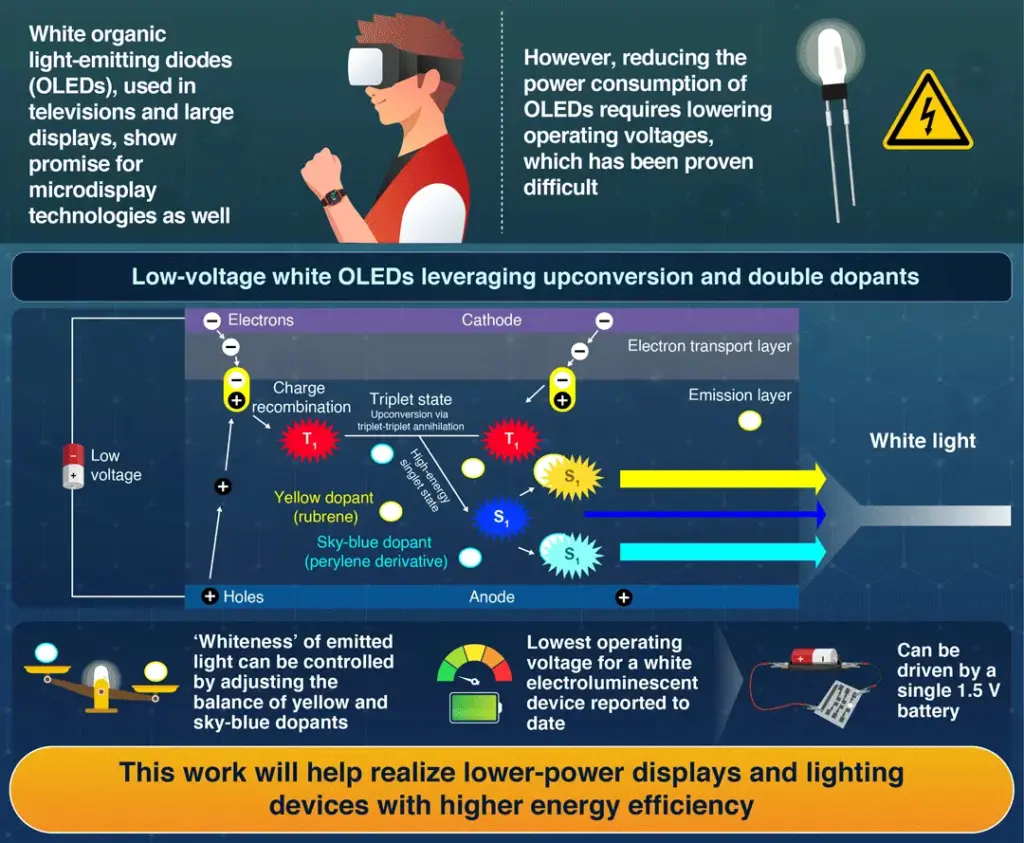
A newly developed white organic light-emitting diode (OLED) operates at under 1.5 volts, according to researchers from the Institute of Science Tokyo, Japan. By employing triplet-triplet annihilation to generate blue light at low voltage and integrating yellow and sky-blue dopants, the research team achieved efficient white emission. This breakthrough holds the potential to significantly reduce energy consumption in advanced displays, including television backlights and lighting devices, and could propel the evolution of portable electronics and sustainable technologies.
Towards Energy-Efficient Microdisplay Technologies
Organic light-emitting diodes have revolutionized display technologies, offering vibrant colors and sleek designs across a range of devices from televisions and laptops to immersive virtual reality gadgets. Despite their unparalleled visual quality, OLEDs face a critical limitation: white OLEDs have relatively high power consumption, which has hindered their widespread adoption in smaller, battery-operated devices.
This energy-intensive nature is primarily due to the high voltage required to produce white light. Current white OLED technology typically demands more than 2.5 volts to operate, largely because of the voltage needed to generate blue light, a key component of white light. Despite extensive research into enhancing the efficiency and color quality of white OLEDs, reducing their operating voltage has remained a formidable challenge.
A Breakthrough in White OLED Technology
In a recent study, a research team led by Associate Professor Seiichiro Izawa from the Materials and Structures Laboratory at the Institute of Science Tokyo has achieved a remarkable breakthrough. Their paper, published in the Journal of Materials Chemistry C on July 24, 2025, details the successful development of a white organic electroluminescent device that operates at an unprecedentedly low voltage.
The team built upon their previous work in creating low-voltage blue OLEDs using an upconversion process based on triplet-triplet annihilation (TTA). This strategy involves using a low voltage to drive the movement of negative and positive charges within a layered organic semiconductor device. When these charges meet and recombine, they produce excited electronic states known as triplet states. These states can annihilate each other through TTA, resulting in a higher-energy singlet state, which produces blue light as it decays.
Innovative Use of Dopants
To achieve the desired white light, the researchers introduced two differently colored dopants into the emissive layer of the semiconductor device: a sky-blue dopant (a perylene-based dopant, Tbpe) and a yellow dopant (rubrene). Energized by the high-energy singlet states in the host material, these dopants emit light of their respective colors. The resulting light is white, as yellow and blue are complementary colors. The researchers carefully adjusted the ratio of each dopant to properly tune the ‘whiteness’ of the output.
“To the best of our knowledge, this is the lowest operating voltage reported to date for white OLEDs,” highlights Izawa.
Implications for Future Technologies
The newly developed white OLED boasts a turn-on voltage of less than 1.5 volts, allowing it to be directly operated by a single 1.5-volt dry battery. By enabling lower operating voltages in white OLEDs, this study could lead to new display designs in portable electronics, including wearable devices for entertainment, sports, and health applications.
“Our achievement could contribute to the realization of a more energy-efficient society by enabling lower-power-consuming displays and lighting devices,” notes Izawa. As the research team continues to refine this technology and address remaining challenges such as efficiency and color stability, this work brings us closer to a future where even high-quality displays consume minimal energy.
As the global demand for energy-efficient technologies grows, advancements like this in OLED technology are crucial. The move represents a significant step forward in reducing the environmental impact of electronic devices, aligning with broader sustainability goals worldwide.
Looking ahead, the potential applications of this technology extend beyond consumer electronics. The principles behind this low-voltage OLED could inform the development of energy-efficient lighting solutions for various industries, contributing to a reduction in global energy consumption.
As researchers continue to innovate, the future of display technology looks promising, with the potential for more sustainable and efficient solutions on the horizon.






